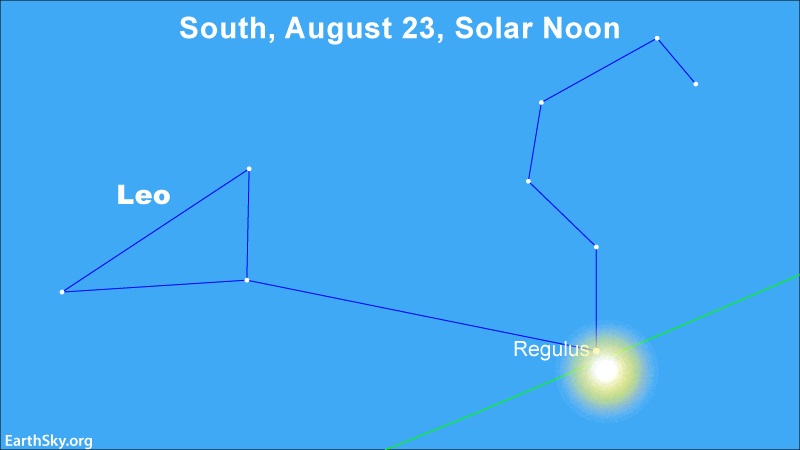
Sun-Regulus in conjunction
If you follow astronomy, you hear the word conjunction a lot. Most of the time, it alerts you to something cool to see in the night sky. It’s usually two objects close together on the sky’s dome. But the word conjunction doesn’t always mean something to see.
For example, on August 23, 2021, the sun will be in conjunction with Regulus, the brightest star in the constellation Leo the Lion. You won’t see Regulus at all on this date, or near this date. At conjunction, this 1st-magnitude star rises with the sun, climbs highest up for the day with the sun at solar noon, then sets with the sun.
Every year, the sun meets up with Regulus for a yearly conjunction on or near August 23. At its conjunction with the sun, Regulus leaves the evening sky to enter the morning sky. By around the September equinox, look for Regulus to light up the eastern sky before sunrise.

The sun travels the zodiac
If you could see the stars during the daytime, you’d see the sun moving approximately one degree (two sun-diameters) eastward in front of the constellations of the zodiac daily. For reference, the sun’s angular diameter equals about 1/2 degree. The day after conjunction – on or near August 24 – the sun moves about one degree east of Regulus.
One month later, the sun will be nearly 30 degrees east of Regulus on the sky’s dome. Some six months from now – about one month before the March 2022 equinox – the sun will have moved 180 degrees from Regulus on the sky’s dome.
Therefore, in late February, look for Regulus to shine all night long, from dusk until dawn. Then Regulus will rise in the east around sunset. Then this star will climb highest up for the night around midnight, and set in the west around sunrise. In the Northern Hemisphere, we associate Regulus’ all-night presence as a welcome harbinger of the spring season.

Bottom line: On or around August 23 every year, Regulus is in conjunction with the sun and lost in the sun’s glare. Regulus will return to the morning sky around the September equinox.
The post Sun-Regulus in conjunction August 23 first appeared on EarthSky.
from EarthSky https://ift.tt/2Uz2qvX

Sun-Regulus in conjunction
If you follow astronomy, you hear the word conjunction a lot. Most of the time, it alerts you to something cool to see in the night sky. It’s usually two objects close together on the sky’s dome. But the word conjunction doesn’t always mean something to see.
For example, on August 23, 2021, the sun will be in conjunction with Regulus, the brightest star in the constellation Leo the Lion. You won’t see Regulus at all on this date, or near this date. At conjunction, this 1st-magnitude star rises with the sun, climbs highest up for the day with the sun at solar noon, then sets with the sun.
Every year, the sun meets up with Regulus for a yearly conjunction on or near August 23. At its conjunction with the sun, Regulus leaves the evening sky to enter the morning sky. By around the September equinox, look for Regulus to light up the eastern sky before sunrise.

The sun travels the zodiac
If you could see the stars during the daytime, you’d see the sun moving approximately one degree (two sun-diameters) eastward in front of the constellations of the zodiac daily. For reference, the sun’s angular diameter equals about 1/2 degree. The day after conjunction – on or near August 24 – the sun moves about one degree east of Regulus.
One month later, the sun will be nearly 30 degrees east of Regulus on the sky’s dome. Some six months from now – about one month before the March 2022 equinox – the sun will have moved 180 degrees from Regulus on the sky’s dome.
Therefore, in late February, look for Regulus to shine all night long, from dusk until dawn. Then Regulus will rise in the east around sunset. Then this star will climb highest up for the night around midnight, and set in the west around sunrise. In the Northern Hemisphere, we associate Regulus’ all-night presence as a welcome harbinger of the spring season.

Bottom line: On or around August 23 every year, Regulus is in conjunction with the sun and lost in the sun’s glare. Regulus will return to the morning sky around the September equinox.
The post Sun-Regulus in conjunction August 23 first appeared on EarthSky.
from EarthSky https://ift.tt/2Uz2qvX

Aucun commentaire:
Enregistrer un commentaire